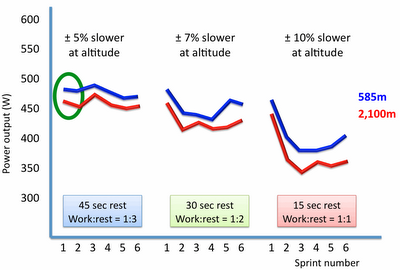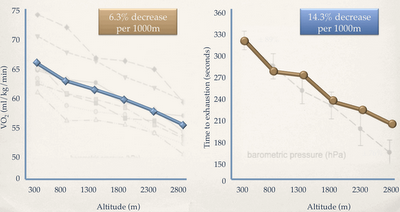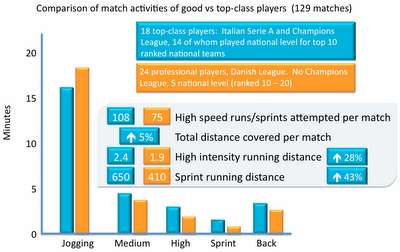The stage has been set to discuss altitude and its effects on football performance., Dr Ross Tucker weighs in.
I was just reading in a local paper that both Denmark and the Netherlands have blamed the altitude for their lacklustre performances in Johannesburg.
The impact of altitude on football is not as clear as its impact on running and cycling. My article on physiology painted a picture of how the key aspect for footballers is the ability to repeat sprints, lasting only seconds, but with short recoveries. Let's now consider the impact of altitude on that performance.
South Africa - a unique elite sports challenge
First, South Africa is unique in that no other country I can think of demands that elite sportspeople perform at sea-level and then at altitude with such regularity and with such short turnaround times.
There are of course plenty of altitude venues, but few that I can think of are utilised as frequently and for the stature of event hosted here. We host European PGA golf events where the transition happens within three days. International rugby is played at sea-level with another match at 1,700m within a week. International cricket matches follow the same pattern. And now so does football.
Recently, there was much consternation because an ATP Tennis Masters Series event was played at the "altitude" of Madrid only a week before the French Open – players felt the altitude would hamper recovery. Madrid is at 650m. Johannesburg is double that, plus 400m. Four weeks of high intensity play, plus training, adds up to a physiological challenge that “scared” a lot of teams (and Fifa) ahead of this World Cup.
Altitude affects performance in various ways. Broadly, there are two effects. One is on the physiology, which is my focus here. The second is on the flight of the ball - reduced air density means faster, further and higher, as any golfer will tell you.
Impact of altitude on repeat sprints
For the clearest illustration of the effect of altitude on exercise, go back to 1968, and the Mexico City Olympic Games. Remember Ron Clarke, a dominant runner heavily favoured to win gold at 10,000m, lying collapsed on the track after the race.
To this day, he blames the altitude for heart problems he experiences. Mexico City's altitude of 2,200m imposed a significant challenge for distance runners, and it's no coincidence that a) the times in those events were uncharacteristically slow in 1968, and b) all the middle- and long-distance events were won by African runners.
Those Africans, who all live and train at altitude, used the 1968 Mexico Olympics to announce themselves to the world as a distance running force.
At the other extreme, sprinters benefit from altitude. Bob Beamon nearly jumped over the sand pit, setting a long-jump world record that would not be challenged for 27 years. 100m, 200m and 400m sprint times were faster than ever.
The reduced air density, punishment for distance athletes, was pleasure for sprinters. It is this factor that may be affecting at least part of the ball-flight in the 2010 WC.,.
For football, the problem is that sprints are repeated over and over, with short recoveries. It's therefore a hybrid of the two extremes.
Below is a graph redrawn from a study by Brosnan et al (2000). Elite cyclists were asked to repeat six 15 seconds sprints at an altitude of either 585 m or 2,100m. This was done three times: Once with a rest period of 45 seconds (a 1:3 work-rest ratio), another time with 30 seconds rest (1:2) and finally with 15 seconds recovery (1:1). The sea-level performance is shown in blue, altitude in red.
Quite clearly, there was an impact, which I would summarise as:
- Altitude reduces sprint performance by between 5% and 10%, depending on the rest period
- When rest is larger (the 1:3 trial, with 45 second rest), performance is 5% worse
- Shorter rest amplifies the altitude effect, and performance is 10% slower
- Very importantly, performance is reduced from the first sprint (circled in green). The body is not so “stupid” as to exercise blindly until the altitude “catches up with it”. Rather, there is anticipation and pacing, so that from the very first sprint, the cyclists produce 5% less power output in response to less oxygen.
The concept of a pacing strategy for football is not one that has been discussed or thought about a great deal. It's difficult to measure, for one thing. But I believe that the biggest impact made by acclimatisation is the improved ability to pace oneself. And the corollary is that teams not adapted will be compromised by this impaired ability to regulate effort over 90 minutes.
This finding was replicated in a study by Feriche et al (2007), where 400m sprints were performed. When rest periods were between one and two minutes long, the 400m times were 10% slower at altitude than sea level. However, if rest periods were increased to five minutes, then the difference in performance disappeared.
The point now is that work:rest ratio has a crucial impact on performance. If the rest increases, the negative effect of altitude is negated.
So, in the World Cup, if teams play at a high intensity, with more off-the-ball movement, and more ball movement to force opposition into reduced rest periods, then the altitude is far more in play than if the tempo is reduced.
So far, I've been surprised at the relative lack of tempo, but that might be the effect the altitude is having on both teams (though of course this is no excuse for France, Portugal, Ivory Coast, who have played at the coast).
Fifa's approach: What altitude?
These studies, plus my own experience of football, hockey and running convince me that the altitudes of South Africa's inland venues have a significant effect on performance. I learned this the hard way, when I first tried to compete at altitude after moving to Cape Town from Johannesburg for my studies.
I was minutes slower over 10km, and played football and hockey feeling like I'd developed asthma, emphysema and sinusitis all at once. The studies suggest the same – the graph below, for example, shows how VO2max (a measure of exercise capacity) and time to exhaustion at high intensity are affected by altitude.
Quite obviously, there is an effect as soon as you head up from sea-level. In fact, the impairment in maximal exercise (shown on the left) is 6% per 1,000m and sustained exercise is affected even larger (right side). So it doesn't happen only at 2,000m. Similarly, the studies I've just looked at above show a 5% to 10% impairment in performance when the altitude difference is 'only' 1500m'.
So imagine my surprise when suddenly Fifa attempted to re-educate everyone that anything from 500m to 2,000m was now going to be defined as "low altitude". And at low altitudes, FIFA said that "minor impairment of aerobic performance becomes detectable" (emphasis mine).
In other words, Fifa was saying: "The 2010 World Cup will not be at altitude, folks, but at low altitude, and so don't worry about its effects. Oh, and the hundreds of studies that have found how even moderate altitude affects performance significantly are not in play, because ‘moderate altitude’ will henceforth be defined as anything from 2,000m to 3,000m. So don't worry about altitude. In fact, what altitude?".
This is not made up - this is effectively what Fifa was saying with its "Consensus Statement", published in the Scandinavian Journal of Medicine and Science in Sports in 2008. In addition, Fifa then attempted to stop scientists in SA from speaking about it. We were told that it was not an item for discussion.
I can only guess this is because they wanted to downplay the impact, because it may detract from the tournament, and also because the selection of base camps by teams could not be biased by this "irrelevant factor". The economic "punishment" imposed on the sea-level hopeful hosts would not be allowed.
Why altitude matters
I must make three points here. First, at the elite level, a 1% impairment in performance is significant. And we know (as shown above) that endurance performance falls off by 14% per 1,000m altitude gain.
We know that a 1,500m difference produced a 7% impairment in repeat sprint performances. That's not "minor" - it's massive. But even if it were minor, it would be relevant to teams hoping to win a World Cup.
Second, Fifa's position is effectively telling the US Olympic Committee, and dozens of others around the world, that their "high-altitude" training centers are in fact at low-altitude, and perhaps should not be bothered with.
I had the pleasure of being hosted by Prof Randy Wilber and my friend Bobby McGee in Colorado last year (altitude between 1,500m and 2,500m), where hundreds of athletes train, and millions have been spent on facilities, which apparently impose little physiological or performance strain (by “consensus”, courtesy Fifa).
The many years of research showing how even moderate increases in altitude affect performance are thus dismissed, simply by redefining the definitions.
Finally, I don't even think it matters in the larger picture, and I don't understand Fifa's desire to keep the issue away from the headlines. The altitude will affect performance, but it won't be decisive. If anything, it adds an interesting angle to the tournament. Just as golfers, tennis players, marathon runners, cyclists must adapt to environment and geography, I see nothing wrong with altitude as a factor.
So what to do - acclimatisation is key
The solution to this is to allow maximal physiological adaptation. Basically, if a team is spending 15 hours a week training, and another 10 hours a week looking at video to analyse opposition to find an edge or weakness, taking supplements, stretching, massaging, doing everything they can, then they cannot simply set aside a factor that can affect them by even 1%, let alone 7%.
At this stage, I must also point out that there are other crucial components to pre-match preparation, which may even offset an altitude disadvantage. For example, if a team feels that the base facilities, environment, support staff and extra-curricular activities are far superior at the coast, then they may well make an informed decision to base themselves at sea-level, and take the altitude knock.
However, to disregard it would be reckless at best. It is no surprise to you to learn that all but a handful of the 2010 teams have chosen to go up to the altitudes to base themselves. They may miss out on the sea and mountains, but they control the physiology.
A big question mark: Research in short supply
So, will altitude affect what you see during the World Cup?
The first point is that research on this is in short supply, so the best we can do is to apply physiological principles, and then infer their effect.But here are my thoughts around what would happen in a match:
* Distance covered per player per match would be reduced. This would be due to two things: One is the decrease in the overall intensity of the game, because players would adjust their "pacing strategy" to conserve energy. Pacing in a team sport is complex, but I've no doubt it exists. The second is that I suspect that the game will slow down more than normal at altitude, as a result of increased levels of fatigue.
* Matches will fail to "ignite" in the second half, remaining low tempo. The drop-off in running distances (at various intensities - jogging, medium, high and sprint) will be greater between first and second halves. So matches will fail to "come alive" in the second half, and games will seem to be meandering along at a low tempo.
* Reduced number of sprints attempted per match. This is related to the pacing issue, but also, players will not recover between sprints. Shorter rests means worse performance per sprint. Therefore, at altitude, players will maximise recovery and sprint less, so that the performance per sprint will be maintained. A drop in the number of sprints means:
* A reduction in the distance covered at high speeds. On average, players run 2.4km at high speed, and about 600m at sprint speeds. This would fall at altitude, primarily because fewer sprints would be attempted.
* Tactical changes would also occur because the ball flies faster at altitude, it will be more difficult to control, both for outfielders and goalkeepers.
* Therefore, ball control skills will be affected.
* Players will shoot more from long distances. It has already been shown that at altitude, players tend to take more shots from further away. Is this coaching? I doubt it. I think players figure out very quickly that they can't control the ball, and deduce that their chances are increased from further out.
So now, let's go to a really interesting study by Mohr.Below is a graph that compares "great" players at a high level of competition to "good" players at a level lower. What it shows is that the high level players (blue bars) do less jogging, but more high intensity and sprint running than lower level players (orange). Great players also sprint more, and cover 28% and 43% more distance at high speeds and sprint speeds, respectively.
Assume that the blue bars now represent elite players at sea-level, while the orange bars represent the elite players at altitude. If the above list of hypotheses was accurate, then the overall impact of altitude on the tournament would be to cause a drop in high intensity running, efforts made and distances covered. This might be best be summed up as:
Altitude turns "great" players into "good" players because it changes their activity profile in more or less the same direction as we see when comparing the highest level of football to a level below it.
Because the impact is the same for all teams (notwithstanding that a few teams have not based themselves at altitude), the overall "dynamic" of the game would not change too much. Which is why it's unlikely to be decisive.
Of course, this is just a theory. It requires proof. And proving this is enormously complex – there are simply not enough games, even in World Cup, to arrive at compelling conclusions.. For instance, note that in the France v Uruguay match, in Cape Town, for example, France covered 101.5km, an average of 9 228m per player, while Uruguay averaged 9,201m per player. Compare this to South Africa's match against Mexico, played at altitude in Johannesburg, saw Mexico covering 10 562m per player, and South Africa 10 805m per player. A huge difference - about 1.5km per player.
Soa match at sea-level can have reduced running, in this case simply because of the way the teams played - France v Uruguay was a conservative, tight match, much of it in the middle of the field, whereas SA v Mexico was, well, frantic. That overrides the impact of altitude.
The point is that a football match is the result of so many factors, that isolating the impact of altitude is nearly impossible.
Altitude and the ball
In all these discussions on altitude, there is a huge effect that I haven't covered yet - the impact of altitude on the flight of the ball.
The Jabulani ball has been slammed left, right and centre (unfortunately, it has not been slammed into the goal often enough) by coaches and players. Part of this may be the ball - it's certainly different.
However, I really do believe that a big part of it is the effect of altitude on ball flight.
For example, a free-kick struck from 30m out with spin, would be expected to curve a total distance of 4m when playing at sea-level. At altitude, because the air density is reduced (in Johannesburg, on a cold night, it would be around 20% lower), the forces acting on the ball are different. The end result is that a ball will fly faster and further, and also deviate less than at sea-level.
How much less? Some calculations show that the ball may move 60cm less in Johannesburg than at sea-level. It will also "dip" less, which is why it would be so much more difficult to get up and over the wall, but down in time for the goals. So when you see yet another free kick fly over by a meter, partly blame the altitude.
So consider a striker who tries to bend the ball around the wall and into the goals from a free-kick - he misses by 50cm to the right. That was a goal at sea-level. At altitude, he blames the ball...
Meanwhile, the goalkeepers are complaining at the erratic movement of the ball, while strikers are complaining that the ball doesn't move enough. Apart from the obvious contradiction of these complaints, I feel that the keepers are judging the reduced reaction time - a shot from 18m out will get to the goal about two ball diameters earlier in Johannesburg than in Cape Town.
That's a significant distance, and it explains why keepers are floundering - their reaction times are 0.1% too slow! Tiny, but enough of a difference.
Dr Ross Tucker, is Health24’s FitnessDoc and has a Ph.D. in Exercise Physiology from the University of Cape Town and a Post-Graduate degree in Sports Management from the UCT's Faculty of Commerce. He is currently employed at the University of Cape Town and Sports Science Institute of South Africa, and works as a consultant to various sporting teams, including South African Sevens, Canoeing, Rowing and Triathlon SA. He also blogs on www.sportsscientists.com




 Publications
Publications
 Partners
Partners

















